Choosing a Garden Leaf Blower & Vacuum

Why Use a Leaf Blower?
As summer draws to a close, many of us can start to find our gardens inundated with increasing numbers of leaves as deciduous trees start shedding their foliage in preparation for the forthcoming winter freeze. Tidier gardeners will be inclined to remove them instinctively, but even if you’re not bothered by the mess it’s worth taking the time to remove them as these leaves can cause several problems if they are left to build up on the ground. Once exposed to rain, they form damp, slimy clumps which can pose a slip hazard on steps and paving, while on lawns they will block sunlight from reaching the grass below, stifle its airflow and create ideal conditions for pests and diseases to flourish. This means that once these large patches of damp leaves are dislodged further down the line, the grass underneath may be dead, diseased or seriously undernourished. One of the quickest and easiest way to get on top of leaf clearing tasks it to invest in a leaf blower, sometimes combined with a vacuum function, and we’ll go through some of the options on the market in this guide.
Using a Leaf Blower: Technique
The traditional method of clearing leaves off a lawn is to use a leaf rake to gather them into easy to manage piles where they can be bagged up, and the leaf blower is typically used in much the same way. By directing the leaves into a pile, they can be scooped up quickly and efficiently, especially if you lay a tarpaulin or similar sheet down first. If your leaf blower has a vacuum function you can use this to suck up these piles of leaves but some of them have quite limited collection capacity and instead they are often used for picking up stragglers, especially in areas where it is hard to shift the leaves, such as when they are stuck in hedges or between plants, rocks and plant pots for example.
Although it is a good idea to tackle this job as regularly as possible, there are a couple of optimum weather conditions that are worth waiting for. Firstly, and most importantly, when the leaves are wet it takes much more energy to shift them and many blowers will be completely ineffective while vacuum collection bags may become infested with damp, and, subsequently, mould. Therefore, it is best to wait for a dry spell to give the leaves time to dry out first. Secondly, as you might expect, windy days can wreak havoc with any attempt to blow leaves in a controlled manner and calm weather is ideal, though you can always attempt to blow the leaves in the same direction as the wind to minimize any disruption.
Different types of Garden Leaf Blower & Vacuum
When choosing a leaf blower, your main consideration will most likely be the machine’s power requirements and each of the three main options (corded electric, cordless electric and petrol powered) has its advantages and disadvantages. which we’ll take a quick look at now.
Corded Electric Leaf Blowers
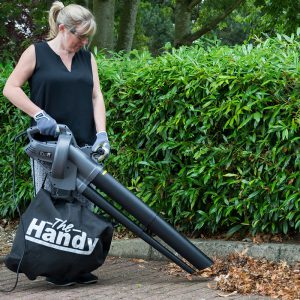
Corded electric blowers have two significant advantages; firstly they are the cheapest types of leaf blowers & vacuums to buy (and use), and secondly they won’t run out of power halfway through a job. For people with small gardens, this may be enough to sway the decision straight away. The trailing power lead is not so much of an irritation as it can be with machines like lawnmowers and hedge trimmers, especially as there is no risk of cutting through it, and as long as you have a suitable extension lead you should have no problems getting into every corner of the average small or medium sized garden. On top of this, you can rely on a corded machine to be ready for use throughout its working life. You don’t have to worry about charging batteries (or replacing any that become lost or worn out), and you don’t have to worry about buying, storing and mixing fuel for a petrol engine, along with the associated maintenance tasks to keep it running smoothly. Electric blowers are also much lighter, quieter and more user friendly than petrol machines, which expose the operator (and anyone in the immediate vicinity) to loud noise and noxious fumes.
In terms of disadvantages, the most obvious one is the radius of operation, which is restricted by how far you can operate from the nearest power socket. Power leads may also not be ideal for gardens with lots of obstacles to negotiate, and people who have got used to the convenience of cordless tools may simply be put off by the notion of dragging the extension lead out every time you need to use the tool. Additionally, most electric garden tools fall behind their petrol counterparts in terms of power, and do not typically deliver the same performance when it comes to heavy duty applications.
Cordless Electric Leaf Blowers
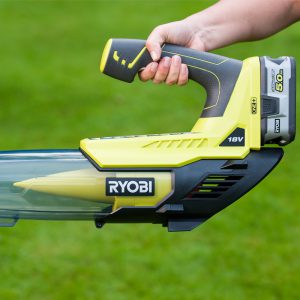
These days, “cordless electric” nearly always means lithium ion battery powered. In fact, previous battery technologies like Ni-Cad are no longer allowed to be used in new power tools, and the low self-discharge rate and absence of memory effect of lithium ion battery technology has made it the go-to solution for a wide range of portable devices. Just about every power tool manufacturer on the planet has a lithium ion battery platform these days, and if you already own cordless tools there’s a good chance there may be a leaf blower on the market that uses the same batteries and chargers that you already own. Although they are an expensive option when purchased with batteries and charger, the option of buying body only machines which are compatible with your existing equipment brings these machines down to a much more attractive price point. Also attractive is the sheer convenience of battery power: stick a charged battery in, and you’re good to go. This greatly reduces time spent doing additional tasks like untangling and unwinding cables and extension leads or mixing up fuel. Like their corded electric counterparts, cordless electric leaf blowers are lighter than petrol machines, without the noise, fumes and regular maintenance, but they also benefit from go-anywhere portability that means they can be used over a wide area as long as they have charge in their batteries.
Because of recent advances in battery technology (enabling much better performance) and the convenience they bring to the table, lithium ion garden tools have surged in popularity over the last decade or so. However, they do have their disadvantages. Historically, they have been underpowered, especially in comparison to petrol machines, and though tools like the DeWalt DCM572 54v Flexvolt Blower are closing the gap, petrol still has the edge when it comes to power and runtime. Cordless blowers can deplete even high capacity batteries fairly quickly, and larger tasks may require more than one battery to complete without disruption. On top of this, lithium ion batteries are expensive and will eventually wear out to the point that they will need replacement.
Petrol Leaf Blowers
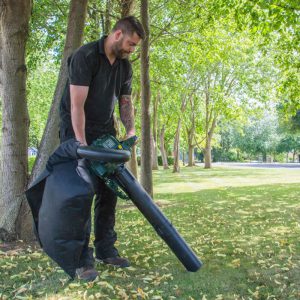
A petrol leaf blower has been the mainstay of professional landscapers for years and they are still the most popular choice for heavy workloads. Suitable for clearing large areas, they are powerful enough to shift stubborn clumps of leaves and will keep running as long as there is fuel in the tank.
Unfortunately, as already discussed, they are not the most user-friendly of tools. Petrol engines need to be looked after to ensure continued operation, and they are not very forgiving of careless maintenance or misuse. The safe storage and transport and fuel can be a concern for many users, and topping up in between jobs can be a hassle. It is also hard to use a petrol blower discreetly – they make a lot of noise and the smell of exhaust fumes coats hair and clothing as well as carrying into neighbouring properties. They also tend to be heavier than electric variants, and many are designed to be strapped to the operator’s back to spread the weight more comfortably for extended use. For these reasons, their main appeal will be to heavy duty users who can overlook these inconveniences in favour of the superior performance and runtime of a combustion engine.
Leaf Blowers vs Blower Vacs
Another main distinction between the types of leaf blower is that some of them can be used for vacuuming as well as blowing, while others are blowers only. We’ll go over the pros and cons of each type now.
Leaf Blowers
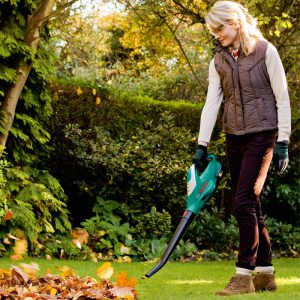
A standard leaf blower may not be as versatile as a blower vac but it also confers some advantages. First of all, you don’t have to cover the additional costs needed for the vacuum functionality when purchasing one, but these machines also tend to be much more streamlined and lightweight, with lower power requirements. This means that the majority of battery powered blowers fall into this category (though there are several battery powered blower vacs on the market should you require one). They can also be less fatiguing to use and take up less room in storage. A suction facility can save time and effort spent bending over to collect leaves from the ground, but if this is not a major concern you may find that the reduced bulk, reduced cost and straightforward ease-of-use that comes with a standard leaf blower makes it a preferred option.
Blower Vacs
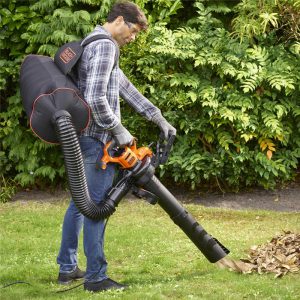
While standard leaf blowers tend to be quite straightforward in their implementation, blower vacs come in a variety of different incarnations. One of the main things to take note of is how the machine switches from blower to vacuum mode; on some models this is a simple case of flicking a switch, while others are supplied with separate blower and vacuum tubes which need to be swapped over each time you want to use the tool in either mode. While interchangeable tubes can be a major inconvenience if you need to switch tasks regularly, models with fixed tubes tend to be bulkier and more unwieldy so may be fatiguing for some users.
Most blower vacs have an integrated blade (often called a mulching fan or shredding fan) which shreds the leaves into fine debris as they are collected. This enables the leaves to be easily compacted down and accelerates their rate of decomposition for use as compost. On some blowers this is achieved with a plastic fan but the best models have metal blades which offer superior long term performance, being better able to survive impacts from solid objects like stones as well as breaking down debris like twigs and branches that get picked up unintentionally.
You’ll also want to check the collection capacity of any machine you’re considering. The larger the bag, the less time you’ll spend emptying it. Blowers with small bags are ideal for sucking up any stragglers left behind after herding the leaves into piles, and especially for tackling leaves that are stuck in between plants or other objects, while the higher capacity models are more suitable for picking up and shredding piles of leaves after they’ve been gathered.
Other Things to Consider when Choosing a Leaf Blower & Vacuum
Although leaf blowers & vacuums can greatly speed things up, the traditional leaf rake can still be a great asset for herding up stray leaves or quick clean-up tasks and makes a highly useful supplementary tool to any leaf blower or blower vac. It’s also important to bear in mind that there are a handful of safety considerations when using any leaf blower. All models are capable of throwing up airborne debris which can easily get into your eyes so eye protection is recommended, along with hearing protection if you are using a petrol machine. When using any corded electric tool outdoors it is advisable to make sure there is an RCD in the circuit to minimize the risk of hazardous electric shock, and if you are using petrol make sure you have taken the necessary steps to store it safely and away from residential buildings.
Categories discussed in this article:

We decided to try a Lithium-Ion cordless blower this season. We have a large corner lot and electric is impossible for a portion of it and it was a good chance to try the newer cordless blower. It’s been great, really enjoy using it.
Thanks for the article!